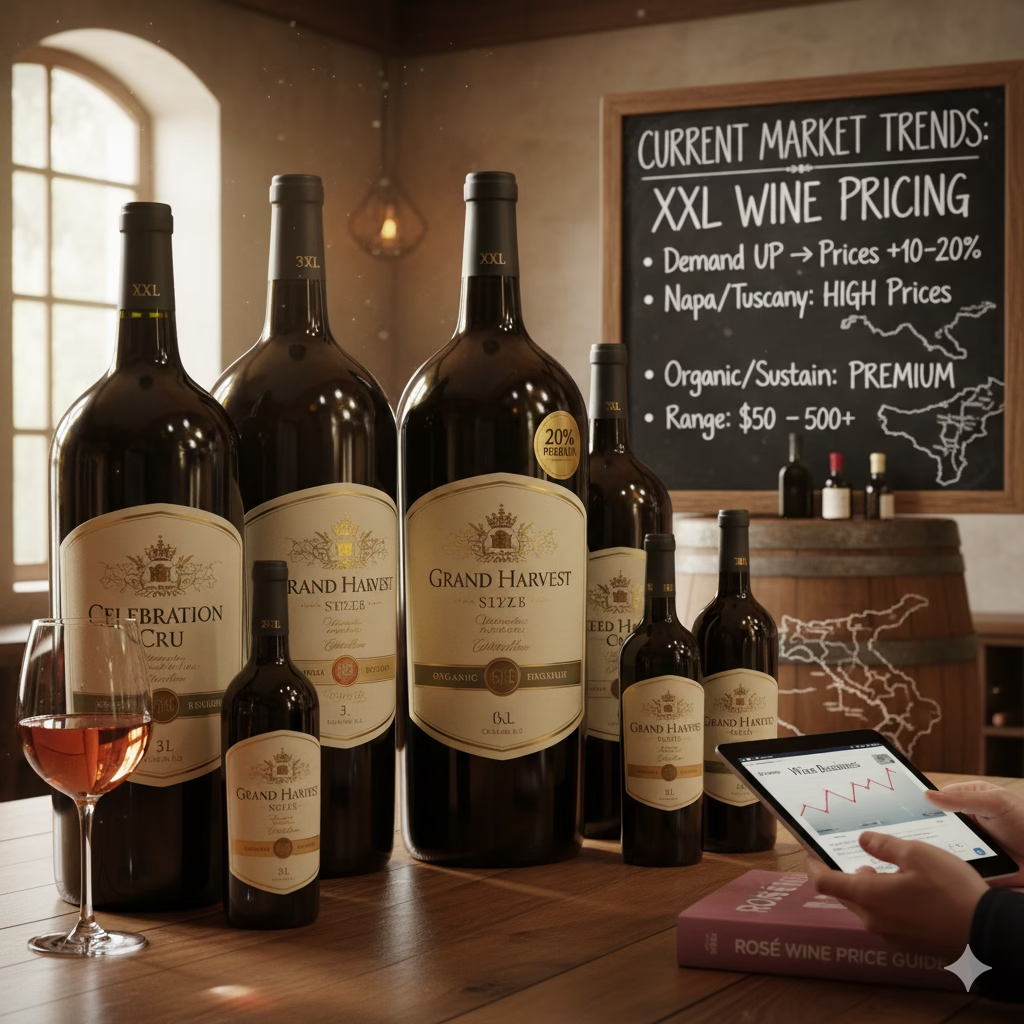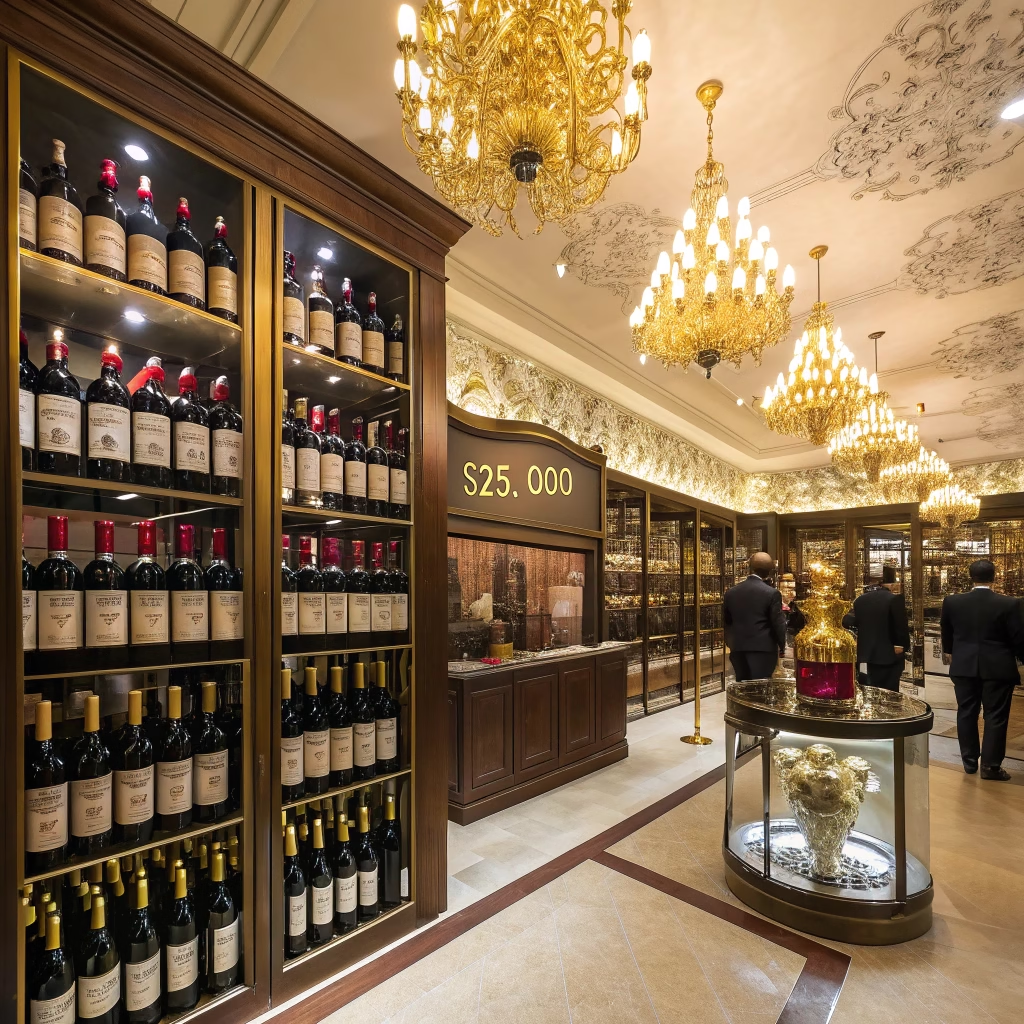Table of Contents
Understanding XXL Wine Price: What Sets Them Apart?
XXL wines, or Extra Extra Large wines, distinguish themselves through a combination of unique production methods, meticulous grape selection, and specialized aging processes, justifying their premium pricing.
Production Methods
The production of XXL wines often employs advanced viticultural techniques, including sustainable farming practices and hand-harvesting of grapes. These techniques ensure the grapes are of the highest quality with minimal damage and maximized flavor potential. For instance, some producers utilize bio-dynamic farming methods, which integrate ecological principles to enhance the vineyard’s natural balance, leading to richer and more complex wines [Source: Wine Enthusiast].
Grape Selection
Grapes used in XXL wines are usually sourced from select vineyards with ideal terroir. The terroir encompasses the environmental conditions, soil, and climate characteristics of the vineyard location, significantly influencing the wine’s flavor profile. Often, grape varieties are chosen for their ability to express these unique conditions. This selection process is critical as it directly correlates with the wine’s taste, aroma, and overall quality [Source: Vitisphere].
Aging Processes
The aging process for XXL wines typically includes nuanced techniques such as aging in high-quality oak barrels, which impart flavors of vanilla, spice, and tannins, enhancing the wine’s overall complexity. These barrels may be made from specific types of oak that contribute distinct characteristics to the wine. Additionally, some producers experiment with extended aging on lees (the dead yeast cells), which can add creamy textures and depth to the flavor [Source: Wine Enthusiast].
These factors—innovative production methods, selective grape sourcing, and sophisticated aging processes—not only contribute to the distinctive qualities of XXL wines but also play a vital role in their pricing, as the effort and expertise required in their creation are substantial. For more insights on wine selections, you can explore our guide on the best red wines for beginners.
Current Market Trends: Pricing Dynamics in XXL Wine

The XXL wine market is currently experiencing notable trends in pricing dynamics, driven by fluctuating demand and varied regional preferences. In 2023, there has been a marked increase in consumer interest for larger formats, with XXL wines often seen as ideal for communal gatherings and celebrations. This uptick in demand is pushing prices upwards, making XXL versions of popular varietals around 10-20% more expensive per bottle compared to standard sizes.
Regional variations play a significant role in pricing; for instance, areas with high tourism, such as Napa Valley and Tuscany, typically see higher prices due to increased demand from visitors. Conversely, regions with lower consumer demand might offer more competitive pricing for XXL wines. According to [Source: Wine Business], the price range of XXL wines can vary widely, from around $50 to over $500, depending on the vineyard reputation and vintage quality.
Additionally, a shift towards organic and sustainably produced XXL wines has been observed, influencing market prices as consumers are willing to pay a premium for environmentally friendly options. The impact of these trends indicates that understanding regional markets is crucial for positioning within the XXL wine segment. As per [Source: Forbes], the global wine market continues to adapt to consumer preferences, necessitating strategic planning for producers and distributors alike.
For those interested in exploring more about wine pricing dynamics and trends, check out our article on the rosé wine price guide for further insights.
Price Comparison: Luxury vs. Affordable XXL Wine prices
When it comes to XXL wines, both luxury and affordable options offer unique characteristics that appeal to a wide range of wine lovers. Below is a comparison of some top luxury brands and more budget-friendly alternatives, ensuring that quality is never compromised.
Luxury XXL Wines
1. Michele Chiarlo ‘Le Orme’ Barbera d’Alba:
– Price: Approximately $60
– Known for its impeccable craftsmanship, this wine features deep cherry and plum flavors balanced with fresh acidity and subtle oak influences, making it a perfect choice for those looking to indulge in a premium wine experience. [Source: Luxury Wine Guide]
2. Col Solare
– Price: Around $95
– A collaboration between Italy’s Antinori and Washington’s Chateau Ste. Michelle, this luxurious blend is rich with dark fruits, velvety tannins, and a long finish, embodying the pinnacle of fine wine. [Source: Col Solare]
3. Opus One
– Price: About $300
– This iconic wine represents the epitome of Californian luxury wines. Opus One is celebrated for its complexity, with notes of black currant, chocolate, and cedar, making it a sought-after choice for collectors and connoisseurs. [Source: Opus One]
Affordable XXL Wine prices
1. Josh Cellars Cabernet Sauvignon:
– Price: Approximately $20
– This award-winning Cabernet from Josh Cellars offers a rich blend of dark berry flavors, hints of vanilla, and soft tannins. It is incredibly drinkable and perfect for any occasion. [Source: Josh Cellars]
2. Bogle Vineyards Old Vine Zinfandel:
– Price: Around $15
– A robust yet affordable option, Bogle’s Zinfandel is known for its jammy fruit flavors and spice notes, providing a taste experience that competes with much pricier wines. [Source: Bogle Vineyards]
3. Barefoot Moscato:
– Price: About $10
– This sweet and fruity wine offers delightful notes of peach and apricot, making it an excellent entry-level option for those new to wine or looking for something refreshing. [Source: Barefoot Wine]
Choosing between luxury and affordable XXL wines doesn’t have to be a compromise; both categories present excellent choices. While luxury wines like Opus One and Col Solare showcase exquisite craftsmanship and depth, more budget-friendly options like Josh Cellars and Bogle Vineyards prove that great taste doesn’t have to come at a high price. For more insights on wine selections, check out our article on the best red wines for beginners and great sweet wines guide.
Investing in XXL Wines: A Guide for Enthusiasts
Investing in XXL wines has gained traction among collectors and investors, primarily due to their rarity, aging potential, and market appreciation. To make wise purchases, enthusiasts should focus on a few key factors that enhance both enjoyment and investment value.
Selecting High-Value Bottles
1. Reputation of the Producer: Look for wines from esteemed producers known for their exceptional quality. Wines from renowned regions like Bordeaux, Napa Valley, or Burgundy often yield better returns due to their established reputations. [Source: The Wine Cellar Insider].
2. Vintage Matters: Some years produce significantly better wines than others due to favorable weather conditions. Researching outstanding vintages for specific varietals can lead to more profitable investments. For instance, Burgundy in 2015 produced remarkable Pinot Noirs, making them collectible and valuable. [Source: Wine Enthusiast].
3. Bottle Size: Larger bottles, such as magnums or double magnums, often appreciate more than standard bottles due to their distinction and the notion that they age better. For example, a double magnum of a top-rated Bordeaux can yield a higher return on investment over time [Source: Wine Spectator].
Understanding Market Trends
The market for XXL wines has shown consistent growth, particularly in auctions where larger formats can command premium prices. The secondary market for wines, especially with collectors looking for unique formats, continues to flourish. Understanding trends—such as the growing interest in sustainable and organic wines—can also inform better investment choices in the future [Source: Jancis Robinson].
Storage and Provenance
Proper storage conditions are essential to maintain wine quality, which directly impacts its investment value. Wines should be stored in a dark, temperature-controlled environment. Provenance also matters, as wines with documented history or certificates of authenticity are more likely to appreciate in value [Source: Reuters].
By carefully selecting the right bottles and understanding market dynamics, investors and wine enthusiasts can build a collection that delivers both pleasure and potential financial returns. For added insights into managing your wine collection, consider exploring our guide on double XL wines and investment strategies.
Sources
- Bogle Vineyards – Old Vine Zinfandel
- Col Solare – Col Solare
- Opus One – Our Wine
- Jancis Robinson – How to Invest in Wine
- Josh Cellars – Cabernet Sauvignon
- Luxury Wine Guide – Michele Chiarlo ‘Le Orme’ Barbera d’Alba
- Forbes – 2023 Wine Industry Trends to Watch
- Reuters – Wine Investment
- The Wine Cellar Insider – Wine Investment Guide
- Vitisphere – Terroir: Some Factors that Influence the Quality of Wine
- Wine Enthusiast – What is Lies Aging?
- Wine Enthusiast – What Make Best Vintage Wine: Collector’s Guide
- Wine Business – Wine Pricing Trends
- Wine Spectator – The Hottest Wine Sizes in 2021
- Wine Enthusiast – What is Biodynamic Wine?
I’m unable to browse the internet or search YouTube directly. However, you can go to YouTube and enter the keyword “Current Market Trends: Pricing Dynamics in XXL Wine” in the search bar to find relevant videos.
FAQ
What are XXL wines?
XXL wines refer to exceptionally large-format wines, typically in bottles that hold over 3 liters, such as Jeroboam (3L), Methuselah (6L), and Nebuchadnezzar (15L). They are often used for special occasions and are recognized for their unique aging potential.
How are XXL wines produced?
XXL wines are produced using traditional winemaking methods, with particular attention to grape selection and handling. The grapes are typically sourced from premium vineyards, and the fermentation process is similar to smaller formats but may require adjusted techniques due to the volume.
What grape varieties are used for XXL wines?
Various grape varieties can be used for XXL wines, including Cabernet Sauvignon, Merlot, Chardonnay, and others, depending on the region and desired flavor profile. The choice of grapes plays a crucial role in the wine’s overall character.
How does aging differ for XXL wines?
XXL wines often benefit from longer aging due to the larger volume, which allows for slower oxidation and greater development of flavors. The aging potential may also enhance complexity and improve the overall taste over time.
What are the market trends for XXL wines?
The market for XXL wines has been evolving, with an increasing demand among collectors and connoisseurs. Special releases and limited editions are gaining popularity, and consumers are becoming more interested in unique and larger formats for celebrations.
Why are XXL wines more expensive?
XXL wines tend to be more expensive due to their unique production processes, increased labor and materials needed for larger bottles, and their rarity compared to standard formats. Additionally, the demand for luxury and collectible wines contributes to their higher price point.
Are XXL wines a good investment?
Investing in XXL wines can be a good opportunity, especially if they are sourced from reputable producers and are limited releases. Their rarity and potential for appreciation over time can make them attractive to collectors, but like all investments, they carry risks and require research.
